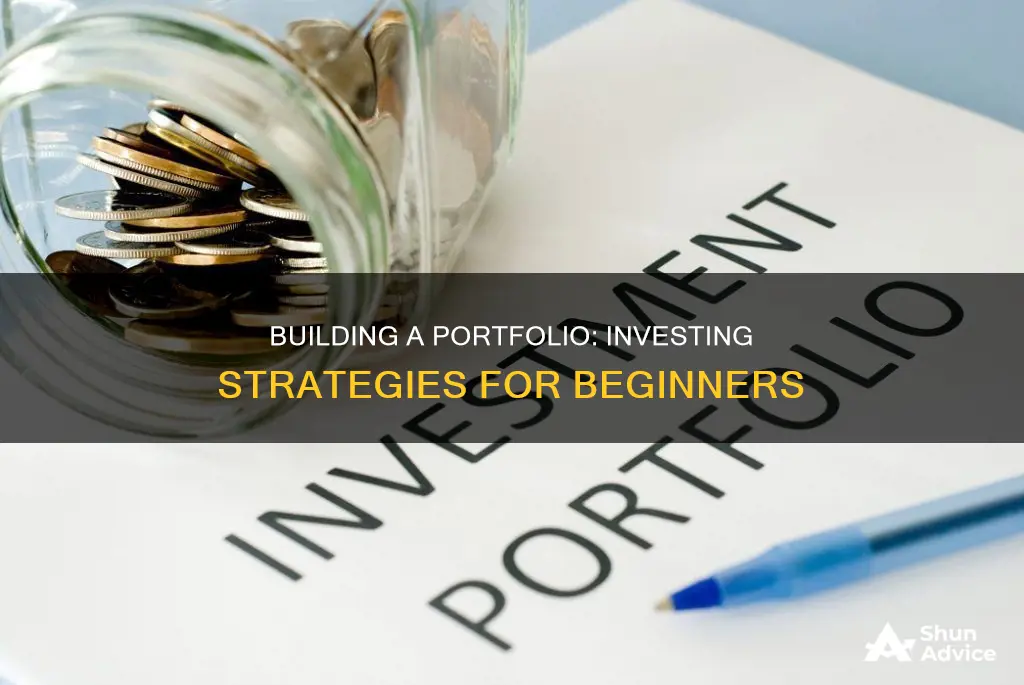
Investing in a portfolio can be a challenging task, but it can be made easier by following a few simple steps. Firstly, it's important to define your financial goals and risk tolerance. Are you investing for retirement, a down payment on a house, or your child's college fund? How much of an unrealized loss are you willing to accept?
Next, you should decide on your asset allocation, which refers to the types of investment assets you select and in what proportions. This will depend on your risk tolerance and time horizon. For example, stocks are generally higher risk and more volatile, while bonds are lower risk and have lower long-term returns. Your portfolio might also include mutual funds, exchange-traded funds (ETFs), or even alternative investments like real estate or cryptocurrencies.
Once you've decided on your investments, it's important to regularly monitor and rebalance your portfolio to ensure it stays aligned with your goals and risk tolerance. This might involve buying or selling certain assets to adjust their weightings in your portfolio.
By following these steps, you can build a strong investment portfolio that has the potential to generate huge rewards in the long term.
| Characteristics | Values |
|---|---|
| First step | Establish your investment profile |
| Second step | Allocate assets |
| Third step | Decide how to diversify |
| Fourth step | Select investments |
| Fifth step | Consider taxes |
| Sixth step | Monitor your portfolio |
| Other considerations | Risk tolerance, time horizon, asset allocation, rebalancing |
What You'll Learn

Establish your investment profile
Establishing your investment profile is the first step in building an investment portfolio. This involves considering your unique personal circumstances, goals, and preferences. Here are some key factors to keep in mind:
Time Horizon
Determine the time horizon for your financial goals. For example, if you are investing for retirement, you may have 20 to 30 years ahead of you. In contrast, investing for a child's college education may give you a time horizon of 10 to 15 years. Understanding your time horizon will help you tailor your investment strategy accordingly.
Risk Tolerance
Risk tolerance is a crucial aspect of your investment profile. It refers to your ability to tolerate fluctuations in the value of your portfolio and your comfort level with potential losses. Consider your personality and how you would handle short-term drops in your investments. Are you willing to take on more risk for the potential of greater returns, or do you prefer a more conservative approach to protect your capital?
Investment Objectives
Based on your time horizon and risk tolerance, decide on your investment objectives. Do you want to create a conservative, moderate, or aggressive portfolio? A conservative portfolio focuses on protecting its value and generating stable income, while a more aggressive portfolio aims for higher returns by taking on more risk.
Financial Profile
Consider your overall financial situation, including your job security, income stability, debt, and other assets. Your financial profile will influence the type and amount of risk you can take on in your investment portfolio.
Comfort Zone with Risk and Returns
If you are on track to meet your investment goals, you may not need to take on excessive risk. However, if you seek higher returns or faster results, you might opt for a more aggressive approach. Keep in mind that taking on more risk also increases the potential for losses.
By carefully considering these factors, you can establish a clear investment profile that aligns with your personal circumstances, goals, and risk tolerance. This foundation will guide your investment decisions and help you build a portfolio that suits your needs.
Diversifying Investment Portfolios: Strategies for Balancing Risk and Returns
You may want to see also

Allocate assets
Allocating assets is a highly personal process that depends on your financial goals, risk tolerance, and time horizon. Here are some detailed guidelines to help you make informed decisions about allocating assets in your investment portfolio:
Determine Your Risk Tolerance:
Firstly, you need to assess your risk tolerance, which is your ability to accept potential losses in exchange for higher returns. Are you comfortable with the possibility of losing some or all of your original investment for the chance of greater returns? This is often referred to as an ""aggressive" investor or one with a high-risk tolerance. On the other hand, a "conservative" investor, or one with low-risk tolerance, tends to favour investments that preserve their original investment, even if it means sacrificing potential gains.
Time Horizon:
Your time horizon is the expected duration, in months, years, or decades, that you plan to invest to achieve a particular financial goal. If you have a longer time horizon, you may feel more comfortable taking on riskier investments as you can wait out market fluctuations and economic cycles. Conversely, if your financial goal has a shorter time horizon, such as saving for a teenager's college education, you would likely opt for less risky investments.
Asset Allocation Basics:
Your asset allocation is the mix of different asset classes in your portfolio, typically including stocks, bonds, cash or cash equivalents, and other alternative investments. Stocks are often considered riskier but offer higher potential returns, while bonds are generally safer but yield lower returns. Cash and cash equivalents, such as savings accounts and money market funds, are the lowest-risk and most liquid asset class.
Diversification:
Diversification is a key concept in asset allocation. It involves spreading your investments across different asset classes, industry sectors, and individual securities to reduce risk. By diversifying, you protect your portfolio from significant losses, as different asset classes tend to perform differently under varying market conditions.
Choosing Investments:
When allocating assets, you can choose from various investment options:
- Stocks: Buying stocks gives you ownership in a company, entitling you to a share of its profits.
- Bonds: Purchasing bonds means loaning money to a company or government, which pays back the principal amount plus interest over time.
- Mutual Funds: These are professionally managed investment funds that pool money from multiple investors to invest in stocks, bonds, or other financial instruments.
- Exchange-Traded Funds (ETFs): ETFs are similar to mutual funds but trade like stocks and track a chosen index or basket of stocks.
- Real Estate: This tangible asset can generate income or long-term appreciation but is relatively illiquid.
- Commodities: These include raw materials like oil, gold, and wheat, offering diversification benefits but with volatile price movements.
Asset Allocation Models:
To help guide your asset allocation, you can refer to common asset allocation models such as conservative, moderate, or aggressive portfolios. A conservative portfolio focuses on capital preservation and lower-risk securities like fixed-income and money market securities. A moderate or balanced portfolio combines stocks and bonds to reduce volatility and is suitable for investors with a mid-to-long-term horizon. An aggressive portfolio primarily consists of stocks, targeting long-term capital growth, and can include some fixed-income securities for diversification.
Regular Rebalancing:
Remember that asset allocation is not a one-time decision. Regularly review and adjust your portfolio to ensure it aligns with your changing financial goals and risk tolerance. This process, known as rebalancing, ensures your portfolio maintains the desired level of risk and helps capitalize on market shifts.
Seek Professional Advice:
If you are unsure about allocating assets, consider seeking advice from a financial professional. They can help you determine an initial asset allocation and suggest adjustments as your circumstances evolve. However, be sure to research their credentials and disciplinary history before hiring anyone.
CDs: Investment or Saving?
You may want to see also

Diversify your portfolio
Diversifying your portfolio is a key part of any investment plan. It's a way to manage risk by investing in a variety of asset classes and different investments within those asset classes. By diversifying, you can smooth out the inevitable peaks and valleys of investing, making it more likely that you'll stick to your investment plan. Here are some tips to help you diversify your portfolio:
- Think beyond stocks and bonds: While these are important components of a diversified portfolio, don't forget about other asset classes such as cash, commodities, precious metals, and real estate. These can add further diversification and help reduce your portfolio's overall volatility.
- Use index funds: Index funds or ETFs are a great way to build a diversified portfolio at a low cost. By purchasing funds that track broad indexes like the S&P 500, you can gain exposure to a diverse range of companies with minimal management fees.
- Consider global investments: Don't forget about investment opportunities outside of your home country. Investing in international markets, such as emerging markets or developed markets like Europe, can provide diversification and potentially higher returns as some countries may have faster long-term growth rates.
- Periodic rebalancing: Over time, the size of the holdings in your portfolio will change as some investments perform better than others. To maintain a diversified portfolio, rebalance your portfolio occasionally to ensure each investment is at the appropriate weight.
- Avoid over-diversification: While diversification is important, it can be taken too far. Holding multiple funds in the same category or funds of funds may not provide additional diversification benefits and can lead to higher fees. Focus on holding a diverse range of uncorrelated assets.
Savings, Investments, and the Economy: National Symbiosis
You may want to see also

Select investments
Once you have an asset allocation and diversification plan, you can start picking individual investments. You might have, for example, set aside 5% for emerging market stocks, so now it's a matter of finding the right investment for that slot in your portfolio.
For your stock bucket, you might use individual shares, mutual funds, or ETFs. If you opt for individual stocks, you'll need to research each company, including sales, profits, market share, management, and competition within the company's industry.
If you go the mutual fund or ETF route, you'll need to decide whether to use actively or passively managed funds. With active funds, managers pick investments they hope will perform better than average, with the goal of outperforming a market benchmark. Passively managed funds, or index funds, try to match the performance of a benchmark index. The most popular of these funds track the S&P 500, but you can also find funds that track mid- and small-cap benchmarks, international indexes, and even indexes that follow specific industries, such as healthcare or financial stocks.
You have similar choices with bonds. You can buy individual government, corporate, or municipal bonds, or you can opt for mutual funds containing bonds, either actively or passively managed.
Stocks
Stocks are a tiny slice of ownership in a company. Investors buy stocks that they believe will increase in value over time. The risk, of course, is that the stock might not go up at all, or it might even lose value. To mitigate this risk, many investors invest in stocks through funds—such as index funds, mutual funds, or ETFs—that hold a collection of stocks from a wide variety of companies. If you do opt for individual stocks, it's usually wise to allocate only 5% to 10% of your portfolio to them.
Mutual funds
Mutual funds allow you to invest in a basket of securities, such as stocks or bonds, all at once. They provide instant diversification to your portfolio and are generally less risky than individual stocks. Some mutual funds are actively managed, but those tend to have higher fees and don't always deliver better returns than passively managed funds, which are commonly known as index funds.
Index funds and ETFs
Index funds and ETFs try to match the performance of a certain market index, such as the S&P 500. Because they don't require a fund manager to actively choose the fund's investments, these vehicles tend to have lower fees than actively managed funds. The main difference between ETFs and index funds is that ETFs can be actively traded on an exchange throughout the trading day like individual stocks, while index funds can only be bought and sold for the price set at the end of the trading day.
Bonds
Bonds are loans to companies or governments that are paid back over time with interest. They are considered safer investments than stocks but generally have lower returns. Since you know how much you'll receive in interest when you invest in bonds, they are referred to as fixed-income investments. This fixed rate of return can balance out the riskier investments within an investor's portfolio.
Viewing Your Acorns Investment Portfolio: A Simple Guide
You may want to see also

Consider taxes
When building an investment portfolio, it is important to consider the tax implications of your decisions. Taxes can significantly impact your overall returns, so it is crucial to make tax-efficient choices. Here are some key points to keep in mind:
- Tax-deferred accounts: Certain types of accounts, such as retirement accounts like IRAs, offer tax advantages. By holding investments that tend to be tax-inefficient, such as taxable bonds, real estate investment trusts, or actively managed stock mutual funds, in tax-deferred accounts, you can defer the tax bill until you start withdrawing funds during retirement. This strategy can help maximize the growth of your investments over time.
- Tax-efficient investments in taxable accounts: In contrast, it is generally advisable to hold tax-efficient investments, such as index stock mutual funds, exchange-traded index funds, tax-managed stock funds, and individual stocks that you plan to buy and hold, in your taxable brokerage account. These investments typically generate lower tax bills, and by holding them in a taxable account, you can take advantage of lower capital gains tax rates when you eventually sell them.
- Rebalancing and tax implications: When rebalancing your portfolio, consider the tax implications of selling certain assets. For example, if you have investments in growth stocks that have appreciated significantly, selling them to rebalance your portfolio could trigger substantial capital gains taxes. In such cases, you may opt to avoid selling and instead adjust your future contributions to other asset classes, gradually reducing the weighting of growth stocks in your portfolio over time.
- Tax-loss selling: On the other hand, if you have investments that have declined in value, selling them can help offset capital gains and reduce your tax liability. This strategy, known as tax-loss selling, can be a useful tool for minimizing your tax burden while also rebalancing your portfolio.
- Tax efficiency and long-term investing: It is worth noting that the impact of taxes on your overall returns is generally lower for long-term investments. This is because the tax benefits of tax-deferred accounts and the lower capital gains tax rates associated with taxable accounts become more significant over time. Therefore, it is essential to consider your investment horizon when making tax-efficient decisions.
Strategies for Allocating Your Investment Portfolio Wisely
You may want to see also







